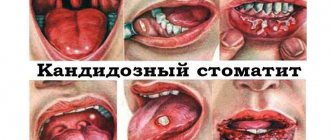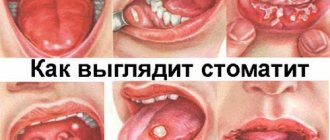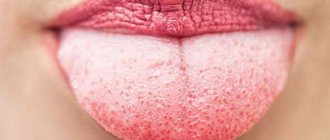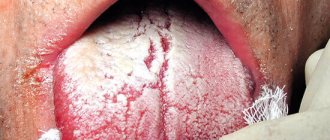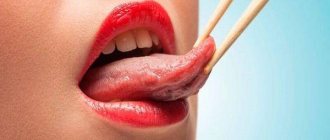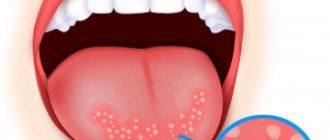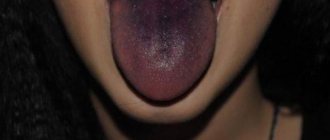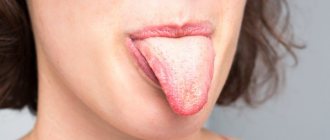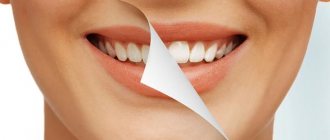What is white plaque in the mouth?
White plaque in the mouth is a common disease. The mucous membrane of the mouth is the center of accumulation and reproduction of many bacteria, which is why it is an indicator of human health, and its main indicator is the tongue.
On this topic
- Raid
How to quickly remove plaque from your tongue
- Maria Konstantinovna Tevs
- October 4, 2020
It is its surface, in addition to the cheeks and gums, that is covered with a whitish coating that is easy to notice. It is important to distinguish and understand when plaque is not serious, since it is caused by a natural reaction of the body, for example, to certain foods, and in which cases you need to sound the alarm and immediately consult a doctor.
The appearance of a dense white plaque is most likely due to infection with a yeast-like fungal infection called Candida, from which the disease is called candidiasis.
Causes
In adults, the so-called oral thrush occurs rarely, since it is more common in infants. Those at risk for candidiasis include older people (60 years and older), as well as those who suffer from reduced immunity.
Among the main reasons for the appearance of white plaque in the oral cavity are:
- diseases of the gastrointestinal tract;
- improper or insufficient oral hygiene
- infectious diseases;
- cancer;
- problems , anemia;
- low stress resistance, constant tension;
- AIDS virus ;
- reaction to medications , especially antibiotics;
- diabetes ;
- vitamins B, C, PP in the body
- tuberculosis;
- dry syndrome ;
- mechanical damage to the oral mucosa due to rough food, improper hygiene, braces, implants, etc.
The fungus that causes candidiasis can occur not only for third-party reasons, but also as a result of infection from another sick person. This can happen when using someone else's toothbrush and other oral hygiene products, sharing spoons, cups and plates, when exchanging saliva during kissing and during sexual intercourse.
Features of therapy
Treatment involves the use of topical drugs and internal medication.
To treat the oral cavity in adults, with very high sensitivity of the mucous membrane, it is allowed to use a diluted Lugol's solution (2 tsp per 200 ml of warm water from a kettle).
You can also lubricate the oral cavity with baking soda diluted in water (1/2 tsp per 150 ml of warm boiled water). The procedure should be carried out 2-3 times a day.
Drug therapy involves the use of antifungal and painkillers. Antihistamines are additionally used as prescribed by an allergist.
Use of antifungal agents
The main antifungal drugs are presented in the table:
| A drug | Description | Mode of application | How to use |
| Ketocanazole, 200 mg | The main effects are antiandrogenic, antifungal, fungicidal, fungistatic. The drug helps inhibit the synthesis of ergosterol, triglycerides and phospholipids. Against this background, fungi lose their ability to form colonies and threads. | Oral | The daily norm is 1-2 tablets for 14 days. Then, after the disappearance of acute symptoms - 1 tablet 24 hours - until the white deposits and ulcers completely disappear. |
| Fluconazole, 50 mg | The main effect is antifungal. Has a highly specific effect. | Oral | 50-100 mg/24 hours, for 1-2 weeks, until the sensation of plaque in the mouth completely disappears. |
| Nystatin, 1% | Effects – antifungal, fungistatic. The presence of double bonds in the composition helps ensure high tropism of the antibacterial drug to the sterols of the fungal cell membrane. | Local impact | The oral cavity should be treated 2 times/24 hours until the white plaque and other symptoms disappear. The approximate duration of the course is 10 days. |
| Clotrimazole, 1% | The product belongs to the group of imidazole derivatives. Effects – antibacterial, antiprotozoal, trichomonacid, broad-spectrum antifungal. | Local impact | The oral cavity is treated 2 times/24 hours until the white plaque disappears. The average course duration is 7 days. |
| Chlorhexidine bigluconate, 0.05% | The main effect is antiseptic. | Local impact | Intended for the treatment of mouth ulcers. 3 times/24 hours, 7 days. |
Use of painkillers
The table shows the most effective analgesics. They are prescribed only according to indications.
| A drug | Description | Mode of application | How to use |
| Lidocaine hydrochloride, 1% | A potent local anesthetic. Effects – antiarrhythmic, local anesthetic. | Local impact | Prescribed against the background of hypersensitivity to amide anesthetics. Used for applications, before meals. |
| Procaine, 5 mg/ml, 0.5% | Local anesthetic. | Local impact | In the form of applications before meals and treating the mouth with antifungal drugs. |
Diagnostics
Identification of the causes of white spots in the oral cavity should be carried out by a specialist. If you find yourself with a dense, uncharacteristic plaque, you should contact your dentist or therapist as soon as possible. Only they are able to determine the source of the disease and prescribe correct and effective treatment.
On this topic
- Raid
Why does white plaque appear after tooth extraction?
- Olga Alexandrovna Novikova
- October 4, 2020
During the appointment, the patient must undergo a set of tests, including:
- scraping from the mucous membrane;
- complex test ;
- a detailed study of the entire history of a person (anamnesis).
If the cause of the white plaque in the mouth is candidiasis, then the spores of the fungal infection Candida will be detected by microscopic analysis. After a final examination of the results, specialists draw up a treatment plan tailored to each patient individually.
White-yellow coating on the tongue
If the coating on the tongue is white-yellow in color, this clearly indicates diseases of the liver and gall bladder. You may have cholecystitis, bile stasis, biliary dyskinesia. Stagnation of bile must be treated to avoid the appearance of gallstones.
There may be gallstones. It could be viral hepatitis. A yellow color at the base of the tongue can also be a sign of jaundice. Moreover, a yellow coating on the tongue is often accompanied by bitterness in the mouth and nausea, there may be a bitter taste in the mouth, and sometimes vomiting.
Treatment
The treatment prescribed to the patient is aimed not only at eliminating unpleasant sensations, fighting the Candida fungus and the disappearance of white plaque, but also at a general increase in immunity and treatment of chronic diseases that cause the possibility of white plaque appearing in the oral cavity again.
Treatment can be divided into general and local.
General therapy
Provides for getting rid of thrush in the oral cavity by taking dosed medications that affect the entire human body. First of all, such drugs are imidazoles or polyene antibiotics - antifungal agents that fight it throughout the body, and not just locally in the mouth.
On this topic
- Raid
5 effective methods for treating plaque on teeth
- Olga Alexandrovna Novikova
- September 3, 2020
In addition, your doctor may prescribe medications that have antiparasitic and antimicrobial effects, which are aimed at stopping the growth and spread of fungal infections in the body. Restoration and further maintenance of immunity is one of the main components of the entire course of treatment.
Most often, in the body with a weak immune system, there is a lack of vitamins B, C and PP, so during therapy it is necessary to eat foods rich in them or special dietary supplements. The selection of all medications, as well as the course of treatment, is selected by a specialist purely individually, depending on the characteristics of the body, the development and causes of the disease.
The drugs included in the course of therapy also include iron supplements, antihistamines, and calcium gluconate. On the part of the patient himself, in addition to strict adherence to the prescribed medications, adherence to dietary nutrition is also required.
Products with a high sugar content, as well as flour, should never be consumed during therapy, as they provoke the growth of fungus. It is not recommended to include salty, hot and spicy foods in your diet, as they cause even greater discomfort, irritating the oral mucosa.
Local therapy
The patient must take local medications that affect the mucous membrane. They are aimed at restoring those tissues that have been damaged by a fungal infection, getting rid of discomfort, and stopping the growth and reproduction of the Candida fungus.
On this topic
- Raid
9 reasons for the formation of a brown coating on the tongue in adults
- Olga Alexandrovna Novikova
- September 3, 2020
Another important step in local therapy is rinsing the mouth with diluted solutions. As a rule, in order to create an environment in the patient’s mouth in which the fungus is unable to live and grow, weak iodine solutions and solutions with an alkaline environment and a disinfecting effect are used.
Resorption of bactericidal lozenges also has a good effect. Dental gels are another possible effective solution to local problems of oral candidiasis. Experts recommend the Cholisal gel because it has a long-lasting analgesic effect and fights inflammatory processes. Pain relief occurs almost immediately after three minutes and lasts up to eight hours.
One of the reasons for the appearance of candidiasis can be incorrectly performed dental procedures or malocclusion, so to eliminate them you need to visit a dental clinic. It is necessary to standardize daily oral hygiene.
Brush your teeth twice a day; after eating, it is recommended to rinse your mouth with antibacterial solutions. If the patient uses dentures, they require special treatment during the treatment period. The saliva remaining there may contain fungal spores, which will infect the oral cavity again and again when the prosthetic jaw is put on.
On this topic
- Raid
Let's find out how to remove white plaque on the root of the tongue
- Olga Alexandrovna Novikova
- September 2, 2020
The entire course of treatment against candidiasis can last from two weeks to 21 days according to the doctor’s decision. Under no circumstances should you stop treatment on your own earlier than indicated by a specialist.
It may seem to patients that the unpleasant symptoms have passed, the discomfort has decreased and the white plaque has subsided, but if treatment is interrupted at an early stage, the person risks a recurrence of the fungal infection.
Causes of white plaque on the tongue
All adults have a white coating on the tongue. Its appearance in the morning is normal. But if it occurs immediately after cleaning the oral cavity, and begins to become thicker, this may indicate the emergence and progression of some disease.
The reasons for the appearance of white plaque on the tongue in adults are varied:
- Tongue lesions in various diseases - infectious, internal organs, hypovitaminosis, dysbacteriosis, oncology and others.
- Acute and chronic lesions of the tongue itself: inflammation, infections, exposure to medications.
- Not associated with diseases: poor hygiene, eating white foods, alcohol, smoking, unsuitable toothpaste and mouthwash.
Prevention
After a successful course of treatment, the stage of preventive measures begins that will help avoid relapse of the disease. In addition, prevention is extremely necessary for people who have never suffered from oral fungal infections, since a few simple everyday actions will help save the time spent on treatment.
List of preventive measures recommended by experts:
- monitoring the strengthening of one’s own immunity - spending more time in the fresh air, playing sports, eating a healthy diet, especially foods rich in vitamins, taking immunostimulating drugs if necessary;
- quitting smoking;
- scheduled visit the dental clinic as part of preventive care;
- reducing the consumption of sweets and products that provoke the growth of yeast fungi;
- correct selection of a rinse that would not provoke changes in the local microflora;
- Thorough daily double brushing of teeth using toothpaste and dental floss.
